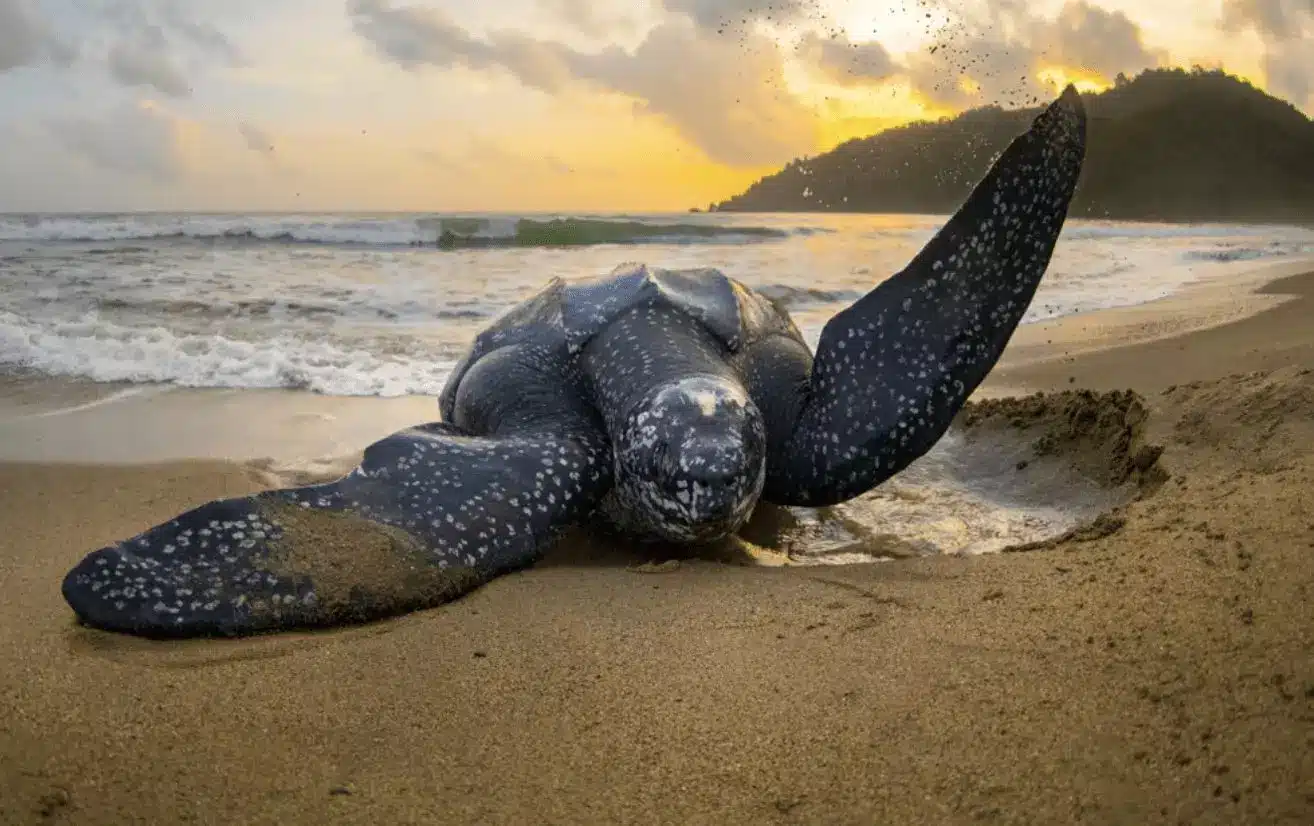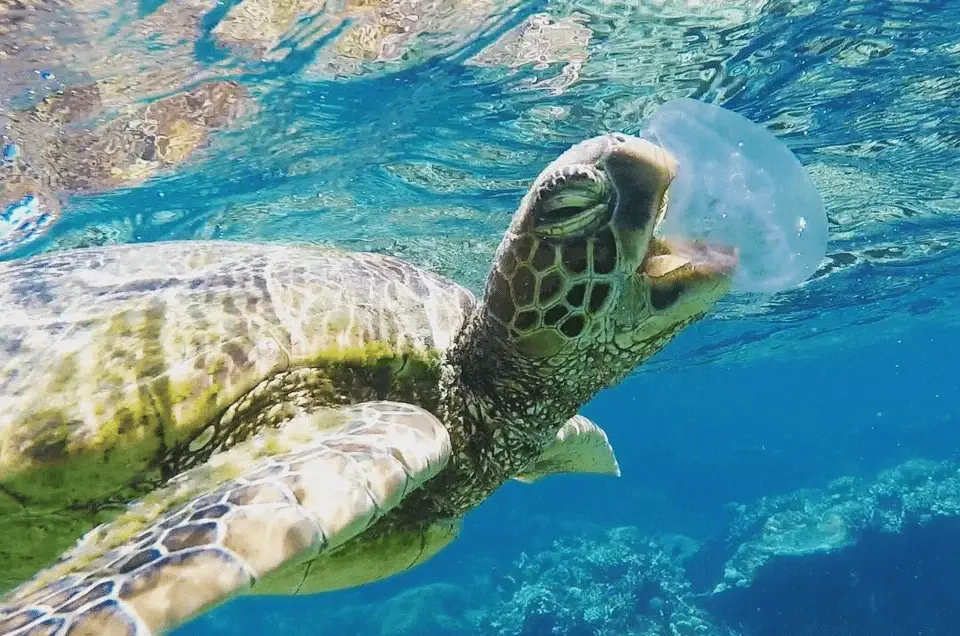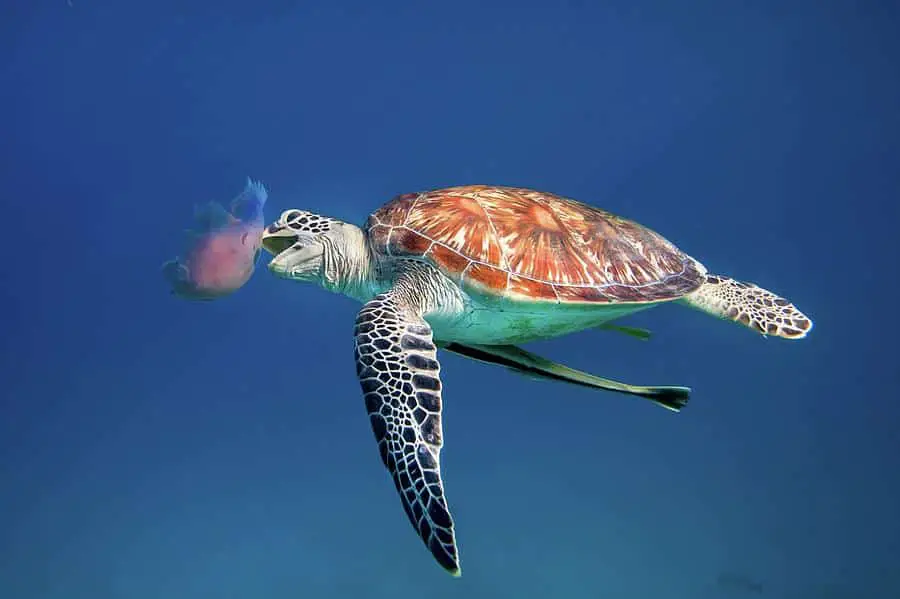Why Do Sea Turtles Eat Jellyfish

Introduction
Why Do Sea Turtles Eat Jellyfish: Sea turtles, magnificent marine creatures that have graced our oceans for millions of years, have been the subject of extensive research and admiration. However, one intriguing aspect of their behavior has baffled scientists and environmentalists alike.
This seemingly peculiar dietary choice by sea turtles has led researchers to delve deeper into the complex relationship between these ancient reptiles and the gelatinous inhabitants of our oceans. At first glance, it might seem counterintuitive for a creature known for its streamlined efficiency in hunting and consuming prey to opt for the slippery, stinging tentacles of jellyfish. Yet, there are compelling reasons behind this behavior.
This phenomenon is not merely a random occurrence but a vital part of the delicate balance within marine ecosystems. Understanding why sea turtles eat jellyfish is not only an intriguing scientific question but also a crucial one for the preservation of these majestic creatures and the oceans they call home.
In this exploration, we will unravel the mystery behind sea turtles’ consumption of jellyfish. We will delve into the factors that drive this behavior, the potential consequences for both sea turtles and the marine environment, and the efforts being made to conserve and protect these fascinating animals. Join us as we embark on a journey to uncover the intriguing world of sea turtles and their enigmatic relationship with jellyfish.

Do sea turtles eat jellyfish?
What a sea turtle eats depends upon the species. Some are omnivores, eating a variety of plants and animals, while the hawksbill and the leatherback are specialists, subsisting primarily of sponges (hawksbills) and jellyfish (leatherbacks).
Sea turtles do indeed eat jellyfish, and this behavior has fascinated scientists and conservationists for many years. While sea turtles have diverse diets that include seagrasses, algae, and crustaceans, they are known to occasionally consume jellyfish. This dietary choice may seem unusual at first, as jellyfish can be challenging to capture due to their slippery and gelatinous nature.
One reason sea turtles eat jellyfish is a case of mistaken identity. Some species of jellyfish resemble the natural prey of sea turtles, such as certain types of soft-bodied invertebrates. In the dimly lit depths of the ocean, where sea turtles often forage, these visual cues can lead to an accidental ingestion of jellyfish.
Another reason for this behavior is opportunism. Sea turtles are known for their adaptability, and they may consume jellyfish when other food sources are scarce. This flexibility in their diet allows them to survive in various ocean environments.
Do sea turtles eat jellyfish and get high?
CLAIM: Sea turtles can get high by eating jellyfish, similar to how marijuana intoxicates humans. AP’S ASSESSMENT: False. Jellyfish do not contain properties that would result in sea turtles becoming high when indulging in the gelatinous marine animal, experts told The Associated Press.
This notion is a misconception and not grounded in scientific reality. Sea turtles consume jellyfish primarily as a part of their natural diet or occasionally due to mistaken identity, as some jellyfish may resemble their prey.
Sea turtles are not seeking any psychoactive or mind-altering effects when they eat jellyfish. Instead, they are driven by their biological instincts and nutritional needs. Depending on the species of sea turtle, their diets can include various marine organisms, and jellyfish might be one of the items they encounter while foraging in the ocean.
It is important to rely on scientific research and facts when discussing the behavior and biology of sea turtles. Promoting misinformation about such fascinating creatures can lead to misunderstandings and potentially harm conservation efforts. Sea turtles are already facing numerous threats, including habitat loss, pollution, and accidental bycatch, so it’s crucial to focus on accurate information and efforts to protect these endangered animals and their fragile marine ecosystems.
Do turtles love jellyfish?
Though almost all of the world’s seven species of sea turtles are omnivorous—meaning they eat pretty much anything, including jellyfish—green sea turtles are mostly herbivorous as adults.
Turtles do not possess the capacity for love or emotional attachment as humans do. Therefore, the concept of turtles loving jellyfish or any other food source is not applicable to their behavior. Turtles, including sea turtles, have instinctual and biological motivations when it comes to their food choices.
When a turtle consumes jellyfish, it is not an act of affection but rather a response to their dietary needs. Turtles are opportunistic feeders and have adapted to eat a variety of marine organisms, depending on their species and the availability of food in their habitat. Jellyfish may be a part of their diet because they provide a source of sustenance, not because of any emotional connection.
It’s essential to understand animals’ behavior from a scientific perspective, recognizing their instincts, survival strategies, and ecological roles. While turtles are fascinating creatures with unique behaviors and adaptations, attributing human emotions like love to their interactions with food sources is anthropomorphism and not accurate in explaining their actions.
Can jellyfish hurt sea turtles?
The venom comes from specialised cells called nematocysts and when made in contact with the human skin, the stung one gets could be awful and at times even fatal. Sea turtles however are reptiles, and their scales can protect them from these venoms.
While sea turtles may consume jellyfish as part of their natural diet, interactions with jellyfish can also be harmful and even fatal for these ancient marine reptiles. The primary danger comes from the stinging tentacles of certain jellyfish species. Sea turtles can inadvertently become entangled in the tentacles while attempting to eat the jellyfish, leading to painful stings. These stings can cause irritation, injury, or even damage to the turtles’ sensitive mouth and throat tissues.
Some jellyfish species have particularly potent venom, which can have more severe consequences for sea turtles. In extreme cases, repeated stings or exposure to highly toxic jellyfish species can lead to injuries that may ultimately prove fatal for the turtles.
Another indirect threat comes from plastic pollution in the oceans, which can lead to confusion for sea turtles. Plastic debris floating in the water can resemble jellyfish, and sea turtles may ingest plastic when attempting to feed on what they perceive as prey. This ingestion of plastics is harmful to their health and can result in digestive issues and even death.
While sea turtles are known to consume jellyfish, they can also face risks and harm from these gelatinous creatures, primarily due to their stinging tentacles and the potential for mistaken identity with plastic debris in the ocean. Conservation efforts to reduce plastic pollution and protect sea turtles are crucial in mitigating these threats.
What sea turtle eats jellyfish?
The leatherback turtle
The leatherback turtle eats jellyfish and little else, but it grows up to 640 kilograms in weight, and can migrate over thousands of kilometres. How can such a powerful giant subsist on such ethereal meals? This is not an easy question to answer.
Sea turtles are fascinating marine creatures known for their unique diet that includes jellyfish. These gentle giants primarily consume jellyfish, among other marine organisms, and their preference for this gelatinous prey plays a crucial role in maintaining the ecological balance of our oceans.
Sea turtles, particularly the leatherback and loggerhead species, are well-suited to feed on jellyfish due to their specialized adaptations. They have powerful jaws and sharp beaks, which enable them to tear through the soft, translucent bodies of jellyfish with ease. Their diet consists not only of the adult jellyfish but also their young, known as polyps, and other related species like salps and sea jellies.
This dietary preference is vital in controlling jellyfish populations. Jellyfish blooms, or large aggregations of jellyfish, can disrupt marine ecosystems by outcompeting other species for food and causing imbalances. Sea turtles help regulate these blooms by consuming jellyfish, preventing them from overwhelming the ecosystem.
However, this unique dietary choice also poses challenges for sea turtles, as they often mistake plastic bags and other marine debris for jellyfish, leading to ingestion of harmful materials. Conservation efforts are crucial to protect these incredible creatures and their vital role in maintaining the health of our oceans.
Are there any risks to sea turtles from eating jellyfish?
There are significant risks to sea turtles from consuming jellyfish. While jellyfish form a substantial portion of a sea turtle’s diet, there are potential dangers associated with this dietary choice. The primary concern arises from the fact that some species of jellyfish are equipped with powerful stingers, which they use to capture prey and defend themselves.
When a turtle ingests a jellyfish, there is a risk that the stingers may still be active and cause damage to the turtle’s digestive system. Additionally, if a turtle consumes a large quantity of jellyfish in a short period, it may suffer from a condition known as “jellyfish ingestion syndrome,” which can lead to blockages in the turtle’s gastrointestinal tract.
The plastic pollution crisis poses an indirect threat to sea turtles. Plastic debris in the ocean can often resemble jellyfish, leading turtles to mistakenly consume it. This can have devastating consequences for their health and well-being.
While jellyfish are a natural part of a sea turtle’s diet, there are substantial risks associated with their consumption. Conservation efforts aimed at reducing plastic pollution and preserving healthy jellyfish populations are crucial in safeguarding the well-being of these magnificent creatures.
Do sea turtles exclusively eat jellyfish?
Sea turtles do not exclusively eat jellyfish. While jellyfish make up a significant portion of their diet, sea turtles are actually opportunistic feeders, meaning they consume a variety of marine organisms depending on availability and their own species. For example, green sea turtles are known to have a broader diet that includes seagrasses and algae, particularly in their juvenile stage.
Loggerhead turtles are more inclined towards a carnivorous diet, incorporating a range of prey such as crabs, snails, and various types of mollusks. Leatherback turtles, the largest of the sea turtle species, have a unique feeding preference for jellyfish, but they also consume other soft-bodied invertebrates.
Hawksbill turtles exhibit a preference for sponges but also eat sea anemones and jellyfish. Olive ridley and Kemp’s ridley turtles have a diet that mainly consists of crustaceans like crabs and shrimp, as well as fish.
While jellyfish are a crucial part of many sea turtle species’ diets, it’s important to understand that their feeding habits can vary widely based on species and life stage. This adaptability allows sea turtles to play diverse roles in their respective marine ecosystems.
How can we protect sea turtles and their food sources?
Protecting sea turtles and their food sources requires a multifaceted approach that addresses both direct threats and broader ecosystem health. Firstly, strict conservation measures are needed to safeguard nesting beaches. Implementing and enforcing regulations to prevent disturbances, such as coastal development and light pollution, is crucial in preserving these critical habitats.
Efforts to combat plastic pollution are paramount. By reducing single-use plastics and implementing effective waste management practices, we can prevent marine debris from entering the oceans and being mistaken for food by turtles. Additionally, promoting responsible tourism and educating coastal communities about the importance of marine conservation can significantly reduce human impacts on sea turtle habitats.
Preserving healthy marine ecosystems is essential for sustaining sea turtle food sources. Implementing marine protected areas and regulating fishing practices to prevent overfishing helps maintain the abundance of prey species. Promoting sustainable fishing practices not only benefits sea turtles but also ensures the overall health of the marine environment.
Rising sea temperatures and changing ocean currents can disrupt the availability and distribution of sea turtle food sources. By reducing carbon emissions and implementing strategies for climate resilience, we can mitigate these impacts and ensure a stable environment for both sea turtles and their food supply.

Conclusion
The enigma of why sea turtles eat jellyfish reveals a complex interplay of ecological and evolutionary factors. While it may initially appear counterproductive for these ancient reptiles to consume gelatinous, stinging creatures, this behavior serves several crucial purposes.
First and foremost, it highlights the adaptive nature of sea turtles. Their ability to switch between diets, including consuming jellyfish, allows them to thrive in diverse ocean environments. Secondly, the consumption of jellyfish by sea turtles helps control jellyfish populations, preventing potential imbalances that could disrupt marine ecosystems.
However, this dietary choice is not without risks. Ingesting plastic pollution, often mistaken for jellyfish, poses a grave threat to sea turtles. Conservation efforts are essential to mitigate this hazard and protect these remarkable creatures.
Understanding why sea turtles eat jellyfish underscores the intricacies of marine life and the fragile equilibrium of our oceans. It underscores the need for continued research, education, and conservation efforts to safeguard both sea turtles and the marine environments turtles inhabit.
As we strive to protect these ancient mariners and their oceanic homes, the enigma of sea turtles consuming jellyfish remains a testament to the intricate web of life beneath the waves, reminding us of the interconnectedness and fragility of our oceans.



